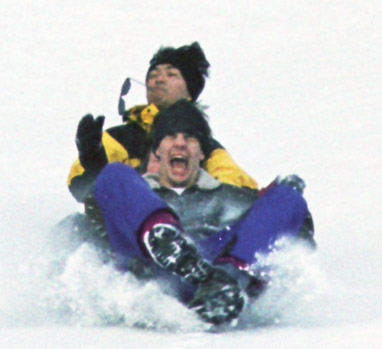The Physics of Sledding
By: Ryan Boothe
Dr. Newman's Physics 211
November 24, 2004
By: Ryan Boothe
Dr. Newman's Physics 211
November 24, 2004
Ever love it when you look out the window the one morning and see that it
had snowed more than a foot of snow? You then get ready as fast as you can,
throw on your snow gear, and rip outside to go sledding down that steep
hill called the Widow Maker. While you sled, you try to find ways to make
the sled go faster, ways to cut corners sharper, and find ways to fit more
people on the sled while hoping to make out alive after hitting the huge
jump at the bottom. As a kid, did you ever wonder how a sled works and why
can you can only go so fast? Or what is it that causes a sled to slow
down?
Sledding is a fun past time that most people love to do. Most people have some funny or interesting story about a sledding experience they had. Stories about how they could not make the turn and wiped out in the bushes, or how much air they got off the jump before they landed on a fellow sledder and crashed.

What I
am going to talk about here is how a sled is affected by the laws of physics.
Such as what laws are acting upon sledders as they are traveling down "The
Widow Maker" or any other hill one may encounter in the woods. There are
several forces that act upon the sled that cause it to slide down a hill
and there are forces which prevent the sled from going down the hill. I
hope to explain what these forces are and how they affect the fun activity
of sledding. I will explain the downhill mechanics of sledding, the laws
of physics of going off a jump, and the energy that is involved in
sledding.

Taken By Ryan Boothe
To find out more:
1. Main Page
2. The Projectile Motion of a Sled off a Jump
3. The Mechanics of Sledding
4. How Much Energy Does it Take to Sled?
5. Bibliography
Sledding is a fun past time that most people love to do. Most people have some funny or interesting story about a sledding experience they had. Stories about how they could not make the turn and wiped out in the bushes, or how much air they got off the jump before they landed on a fellow sledder and crashed.

Taken By Ryan Boothe
To find out more:
1. Main Page
2. The Projectile Motion of a Sled off a Jump
3. The Mechanics of Sledding
4. How Much Energy Does it Take to Sled?
5. Bibliography